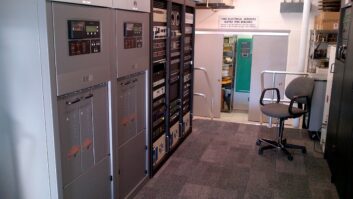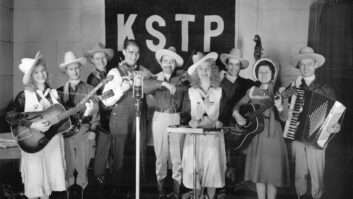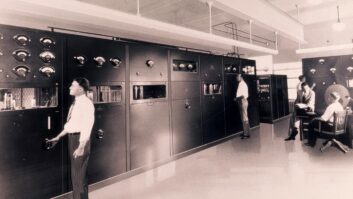Saudia Arabia opened a new front in the civil war in Yemen with the launch of Determination Radio (Itha’ Huna Al-Azm) last September. The troop-supporting station is the latest initiative in a cross-border conflict taking place on air, sea and land.

Determination Radio is a service of the country’s Ministry of Culture and Information and is implemented by the Saudi Broadcasting Corporation, or SBC. Coming on the air with the slogan, “The Voice of Truth,” opening ceremonies included a cake-cutting attended by various dignitaries. The director of the station is Ayman Al-Radadi.
The station’s audience is the Saudi military deployed in the country’s southern border provinces of Jizan and Najran, according to Saudi media reports.

Determination Radio airs both recorded and live programs in Arabic, with at least some of the shows originating from studios in Jizan. The station started out with 12 hours of daily programming, but expanded it to 24 hours after a few months.
Programs include “Southern Shield,” “Southern Pulse,” “The Homeland Unites Us,” “Peaceful Kingdom” and “Yemen Through the Eyes of Its Sons.” At least two programs are devoted to explaining whom the troops are fighting: “Pirates” and “The Spider’s Web.”
Determination Radio is an all-band radio station. On AM, they transmit on 549 kHz from the seaside border town of Jizan with 1 kW and from Najran with 747 kHz with 10 kW. These outlets previously carried the SBC’s General Program.
The station announces a number of FM frequencies. There are two in Jizan province, one on 107 MHz in Farsan, a town in a group of islands in the Red Sea, and another in the mountain resort of Fifa on 99 MHz. In Najran province, they are on 107 MHz in Khubash. The previous status and transmitter powers for these outlets is not known. An additional transmitter on 94.9 MHz broadcasts from South Dhahran with 100 kW and previously carried Radio Jeddah.

SHORTWAVE TRANSMISSIONS
Shortwave is transmitted on 11745 kHz in the 25 meter band. The shortwave frequency is apparently for those outside the coverage of the AM and FM frequencies. Depending upon the time of day, either the site at Riyadh or the Al-Khumra site in Jeddah is used, but which site is used at which time is not public knowledge.
The most likely transmitter to be used at Al-Khumra would be one of the 250 kW Continental transmitters installed in 2011. At Riyadh, there are a number of high-powered transmitters that could be used with powers up to 500 kW. Directional curtain antennas are used at both sites.
Determination Radio’s shortwave setup has advantages and disadvantages. A single shortwave frequency in use 24 hours per day certainly makes for easier branding.

It can also be easier for listeners who will never have to re-tune their radios. Choosing a frequency in the middle of a broadcast band ensures that all shortwave sets will be able to tune into the frequency. Having said that, a shortwave station employing a single transmitter will typical use different frequencies depending upon the time of day and year in order to optimize reception in the target area. Some stations use multiple transmitters operating on different frequencies to maximize coverage.
Stations using shortwave for international broadcasting also ideally coordinate their frequency selection through the High Frequency Coordinating Conference. Working through the HFCC can minimize possible interference from other stations that might want to use the same or adjacent channels.

When Determination Radio started in late 2017, 11745 kHz was an excellent selection, coordination-wise. The frequency was an open channel, that is, no other stations were using it. Although the Saudis register their other services, they did not do so with Determination Radio. This left the impression that the frequency was not in use. Now some other stations have started to use the frequency at certain hours, resulting in potential co-channel interference to Determination Radio.
The station also announces that they are on Arabsat 5, a satellite used extensively by Saudi Arabia for television and radio services.
Saudi Arabia is supporting its troops with this new service. With long-broadcast hours, much original programming, and a massive all-band effort, this is an extensive and expensive operation. Even though we are almost a quarter into the 21st century, radio broadcasts can remain the most important means of communication in a crisis.
Hans Johnson wrote in 2012 about Robert Williams and his Cuba-based broadcasts in the 1960s targeting blacks in the U.S. south.
RADIO SANA’A: THE WAR’S OTHER MYSTERIOUS SHORTWAVE STATION
Radio Sana’a is the shortwave station of the Saudi-backed Yemeni government, but the capital city is no longer controlled by the government. It is the only shortwave outlet connected to Yemen that is on the air.
The station started broadcasting in November 2015. Programs are produced in Aden, according to a press report. The country’s only known high-powered shortwave site near Sana’a is also not under government control. There are also severe power shortages in Yemen, so setting up a shortwave station from another location in the country would be extremely difficult.
So where is this mysterious station coming from? Whoever is carrying the programs has spare shortwave transmitter capacity and the funds to operate it 24 hours a day. The Saudis have both. The pattern of frequency management is similar to Determination Radio with a single frequency in the middle of the 25 meter band (11860 kHz) for the entire 24 hour schedule schedule.
Radio Sana’a was also reported in the press as being on the Badr 4 satellite in addition to shortwave. An examination of programmers on Badr 4 shows a listing for SBC with “Yemen Radio” as one of the sub-channels. There would not be much of an audience for Badr 4 in power-starved Yemen, but it would be an excellent way to feed programs produced in Aden to a transmitter site in Saudi Arabia. And if the Saudis are willing to carry them on satellite, then why not the shortwave as well?
All indications are that the secretive Radio Sana’a is coming from Saudi Arabia.







